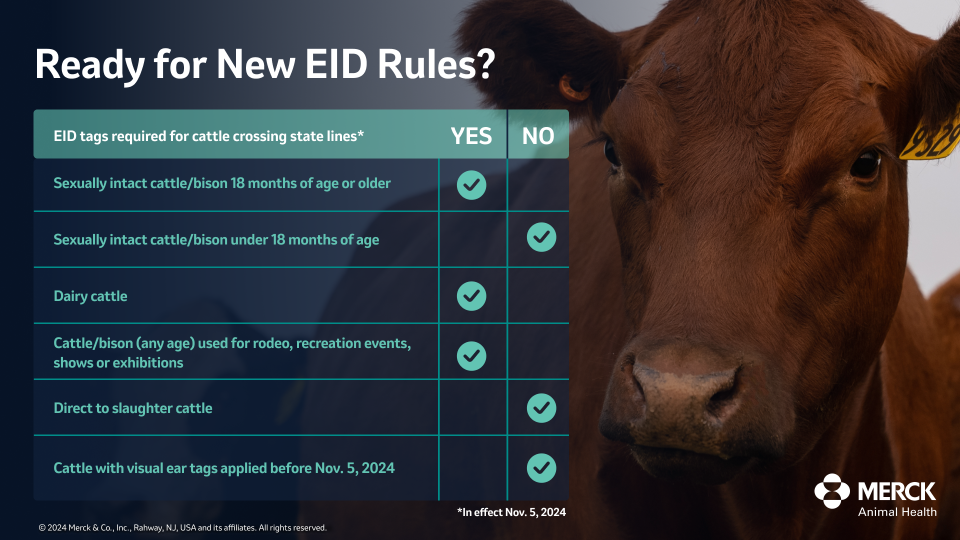New EID Ear Tag Requirements for Cattle 2024 | Merck (original) (raw)
New EID rules spark questions
By Paul Koffman
Confused about USDA’s EID1 requirements? You’re not alone.
We’ve fielded many questions about the new electronic ID (EID) rules for livestock moving across state lines. As the leading provider of EID tags and readers through our Allflex® brand, Merck Animal Health wants to support cattle producers in their decision-making with the expertise and solutions they need.
As part of that effort, we hope to clarify some of the tagging changes to USDA’s Animal Disease Traceability system.

Key distinctions with official ID rules
The new policy only applies to interstate movement. Other exemptions include direct-to-slaughter cattle and sexually intact cattle (and bison) under 18 months of age.
Animals that will need electronically and visually readable tags when they enter interstate movement include:
- Sexually intact cattle and bison 18 months or older
- All dairy cattle, including beef-on-dairy crossbred animals
- Cattle and bison of any age used for rodeo, recreation events, shows or exhibitions
Another important detail: Visual ear tags applied before Nov. 5, 2024, will be recognized as official IDs for the life of the animal. They’ll be grandfathered in and will not need an EID.
**Easing the financial burden
Producers and the livestock industry have raised concerns about the potential cost burden of the new tagging policies. Congress recently directed USDA-APHIS to allocate no less than $15 million for the cost of tags and related infrastructure to help offset those costs.2
Producers may be able to access EID tags for free via their state veterinarian. They can apply those tags at approved tagging sites. Producers can also buy EIDs directly from a distributor, online vendor or local dealer and apply the tags themselves.
In addition, producers are not required to invest in tag-reading hardware or software, unless they choose to do so for herd management and record keeping. The EID tags can be used the same way as visual tags.
**Addressing data privacy concerns
EID tags are encoded with a number that identifies the animal, but no owner-specific information. The data associated with the tags will be stored in various federal and state databases.
Access to that data will also be restricted to the state and federal officials responsible for managing high-impact diseases of the cattle industry.
**USDA agnostic on EID tags
USDA isn’t mandating or recommending any one brand of ear tag. Tags must be approved by the department and will be imprinted with the Official Eartag Shield.
The Allflex radio frequency ID (RFID) tags offered by Merck Animal Health meet these standards. They use a short-read range that doesn’t interfere with radio frequencies commonly found in livestock operations. Allflex tags do not include any global positioning system (GPS) capabilities. Producers also use these RFID tags to track health protocols, performance, reproduction and genetics.
The new tagging requirements are intended to bolster the industry’s tracing capabilities in the event of a disease outbreak. Contact your Merck Animal Health representative or tag supplier to find out how Allflex tags can help you comply with these rules while managing your beef or dairy operation more efficiently.
References
- National Archives. Federal Register. Rules and Regulations. Use of Electronic Identification Eartags as Official Identification in Cattle and Bison. Animal and Plant Health Inspection Service, USDA. May 9, 2024. 89(91):39540-39566. APHIS-2021-0020. 2024-09717.pdf (govinfo.gov). Retrieved May 21, 2024.
- Rachael Oatman. Congress approves $15 million for EID tagging of cattle. Tri-State Livestock News. March 22, 2024. https://www.tsln.com/news/congress-approves-15-million-for-eid-tagging-of-cattle/. Retrieved May 21, 2024.
Find more content for your beef operation.

Paul Koffman
Livestock Technology Solutions Lead, North America
Merck Animal Health